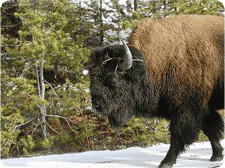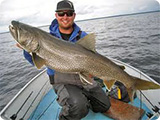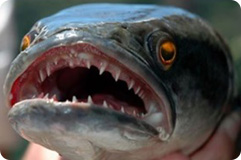







How can genetics help manage and conserve fish, wildlife, and ecosystems?
Genetics contributes in many ways that were unimaginable only a few years ago. In this "age of genomics", there is perhaps no area of science with more potential to improve both nature conservation and the economy or human well-being. For more information, see our Conservation Genetics video or our book (Allendorf et al. 2013)
Five research themes employing genetics at FLBS:
(1) Invasive Species & Disease; (2) Landscape/Riverscape Connectivity and Climate Change; (3) Fitness & Adaptation; (4) DNA Sequencing & Genetic Typing; (5) Data Analysis & Software Development. Details on each research project/theme is below. See Luikart CV for papers.
1. Invasive Species & Disease: how can we stop them?
Aquatic Invasive Species Research at FLBS
Early detection of aquatic invasive species: preventing ecosystem and economic collapse
Read more about invasive threats facing Montana, including Zebra and Quagga mussels, in our AIS white page.

Map of eDNA sampling locations to help protect Flathead Lake from zebra and quagga mussel invasion
If DNA from invasive mussels is detected at potential introduction sites, there is a chance they could be eradicated before they spawn in summer. There is no evidence yet of invasive mussels; however, we are monitoring to provide early detection in case they have arrived because of the recent detection of invasive mussels in eastern Montana. Consider a
today to help ensure the DNA lab testing can be completed ASAP, and to sample more locations. We believe that at least 100 additional locations must be sampled before March to help ensure detection IF the invasive mussels are in Flathead Lake. This is a collaborative effort with Montana-FWP, US Forest Service, White Fish Lake Institute, Flathead Basin Commission, the Flathead Lakers, Swan Lakers, and others (and would include Swan and Whitefish Lakes, pending funding support).
Early detection of aquatic invasive species (AIS) offers the best (and often only) chance of eradication and prevention of spread. This is particularly true for zebra and quagga mussels, as they have never been eradicated from a large water body once broadly established.
FLBS researchers have developed environmental DNA (eDNA) tests for early detection of invasive zebra and quagga mussels, as well as other invasives.
How can you help prevent invasion by insidious zebra mussels and other Aquatic Invasive Species (AIS)?
- Learn more about invasive species by watching the 2016 Invasive Species Video.
- Read more about the dangers and effects of zebra & quagga mussels in our Zebra/Quagga mussel fact sheet.
- You may also view the 2015 Invasive Species Video here.
- Then, consider a
of your time or money to help us prevent the spread of invasive species.
- For even more information about zebra and quagga mussels, visit the USGS Zebra and Quagga Mussel resource page.
For more information, contact Gordon Luikart, Tom Bansak, or call FLBS at 406-982-3301.
Helping to Restore Native Fish Populations: Use of Genetics to Monitor Abundance of Invasive Lake Trout and Native Bull and Cutthroat Trout (Luikart et al. in prep; Waples et al. 2014; Waples et al. 2013; Luikart et al. 2010; Schwartz et al. 2007).
See Luikart CV for papers.
3. Fitness & Adaptation
High Fitness (individual survival and reproduction) is required to maintain healthy fish and wildlife populations. Adaptation (to new environments) is essential to avoid extinction and maintain opportunities for hunting, fishing, as well as ecosystem services.
Does adaptation to captivity (a hatchery environment) reduce fitness in the wild? (see Allendorf et al. 2013, pages 360, 364, 390, 401, 406, 408)
Discovering Genes and Traits Underlying Adaptation to Environmental Change Using Whole Genome Sequencing. (Hohenlohe et al. 2013; Kardos et al. in review)
Does inbreeding reduce fitness? Can restoring gene flow (cross-breeding) restore or increase fitness. (Hogg et al. 2006; Tallmon et al. 2004; Kardos et al. 2014).
4. DNA Sequencing and Genetic Typing
Why is DNA marker development important?
"In less than half a century, molecular markers have totally changed our view of nature…." (Schlotterer, 2004, Nat Rev Gen)We develop and apply new technologies, like exon capture and RAD-capture, for genome wide and gene-targeted marker discovery and analysis in fish and wildlife (Cosart et al. 2011; Hohenlohe et al. 2011, Hohenlohe et al. 2013; Amis et al. 2012; Hand et al. in review)
5. Data Analysis & Software Development
Simulating complex (realistic) population scenarios (demography) improves our ability to detect population fragmentation and decline using DNA markers and novel computational approaches (NewAge; AgeNe; LDNe; GARM) (Pérez-Figueroa et al. 2012; Waples et al. 2014; Luikart et al. in prep)(project text coming soon)
Software for simulating & analyzing spatially explicit landscape genetics scenarios improves understanding of landscape connectivity (CDFish; Landguth et al. 2011; GARM; Hand et al. in review)
Prior Projects


 Preventing Spread of Aquatic Invasive Species (Amish et al. publication in prep; Luikart et al. publication in prep.). Partial funding from the National Science Foundation (USA).
Preventing Spread of Aquatic Invasive Species (Amish et al. publication in prep; Luikart et al. publication in prep.). Partial funding from the National Science Foundation (USA).
 Tracking Brucellosis Spread in Bison, Elk, and Livestock (O'Brien et al. in review; Beja-Pereira et al. 2009; Cross et al. 2011; Hand et al. 2014).
Tracking Brucellosis Spread in Bison, Elk, and Livestock (O'Brien et al. in review; Beja-Pereira et al. 2009; Cross et al. 2011; Hand et al. 2014). Connectivity among Argali sheep from Afghanistan and adjacent countries: noninvasive approaches using neutral and candidate gene microsatellites. Funded by Wildlife Conservation Society (WCF). (Harris et al. 2010; Luikart et al. 2011)
Connectivity among Argali sheep from Afghanistan and adjacent countries: noninvasive approaches using neutral and candidate gene microsatellites. Funded by Wildlife Conservation Society (WCF). (Harris et al. 2010; Luikart et al. 2011) Cross-species Transmission of Infectious Disease: A Population Genomic Approach Tracking Brucellosis in Wildlife, Livestock, and Humans. (Archie et al. 2009; Beja-Pereira et al. 2009; Cross et al. 2013; Benavides et al. 2014; O'Brien et al. in review). Funded by NSF.
Cross-species Transmission of Infectious Disease: A Population Genomic Approach Tracking Brucellosis in Wildlife, Livestock, and Humans. (Archie et al. 2009; Beja-Pereira et al. 2009; Cross et al. 2013; Benavides et al. 2014; O'Brien et al. in review). Funded by NSF. Macroparasite-Microparasite Interactions: Dynamics of Co-infection and Implications for Disease Control. Funded by NSF (Ezenwa et al. 2010; See et al. 2012; Lane-deGraaf et al. in press)
Macroparasite-Microparasite Interactions: Dynamics of Co-infection and Implications for Disease Control. Funded by NSF (Ezenwa et al. 2010; See et al. 2012; Lane-deGraaf et al. in press)